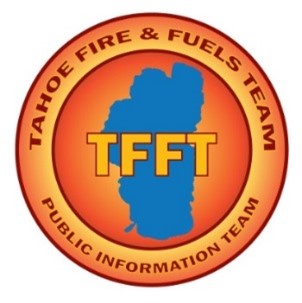Tahoe Fire & Fuels Team to begin Lake Tahoe prescribed fire program

Contact: USDA Forest Service, Lisa Herron (530) 543-2815
LAKE TAHOE, Calif./Nev., Oct. 12, 2021 – Under the coordination of the Tahoe Fire & Fuels Team (TFFT), the Lake Tahoe Basin fall prescribed fire program may begin as early as November, weather, and conditions permitting. Smoke will be present. A map with project locations and details will be available at tahoelivingwithfire.com. To receive email prescribed fire notifications, send a request to
Prescribed fire managers use different methods to reintroduce low-intensity fire in forests including pile and understory burning. Pile burning involves burning slash piles that are constructed by hand and mechanical equipment and is intended to remove excess fuels (branches, limbs, and stumps) that can feed unwanted wildfire. Understory burning uses low-intensity fire on the ground (the understory) to remove excess vegetation (fuels) under specific environmental conditions with fire confined to a predetermined area. Understory burning produces fire behavior and fire characteristics required to attain planned fire and resource management objectives.
“During the Caldor Fire, we observed firsthand that prescribed fire and fuels reduction efforts help firefighters protect homes and neighborhoods,” said Acting Forest Supervisor, Gwen Sanchez. “We will continue to use these effective tools to reduce the amount of dense vegetation that can become fuel for destructive wildland fires.”
Fall and winter bring cooler temperatures and precipitation, which are ideal for conducting prescribed fire operations. Each operation follows a specialized burn plan, which considers temperature, humidity, wind, moisture of vegetation, and conditions for dispersal of smoke. All this information is used to decide when and where to burn.
Smoke from prescribed fire operations is normal and may continue for several days after an ignition depending on the project size, conditions, and weather. Prescribed fire smoke is generally less intense and of much shorter duration than smoke produced by wildland fires.
Prior to prescribed fire ignition, there is close coordination with local and state air quality agencies to monitor weather for favorable conditions that can disperse smoke. Crews conduct test burns before igniting a larger area to verify how well the vegetation is consumed along with how the smoke rises and disperses before proceeding.
Prescribed fire signs will be posted on roadways in areas affected by prescribed fire operations along with email notifications, and updates to the local fire information line maintained by the USDA Forest Service at 530-543-2816. The TFFT gives as much advance notice as possible before burning, but some operations may be conducted on short notice due to the small window of opportunity.
Learn more about prescribed fire, how it’s managed, and its benefits at the upcoming Living with Fire Virtual Series: Prescribed Fire in Tahoe and Nevada. Speakers include Keegan Schafer, wildland fire and fuels division chief with Tahoe Douglas Fire Protection District, and Duncan Leao, forest fuels and vegetation program manager for the USDA Forest Service Humboldt-Toiyabe National Forest.
To learn more about living with fire, visit https://tahoe.livingwithfire.info/get-informed/understanding-fire/.